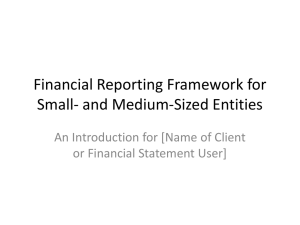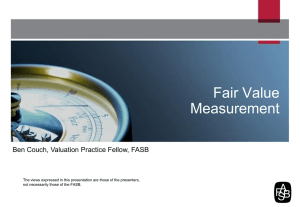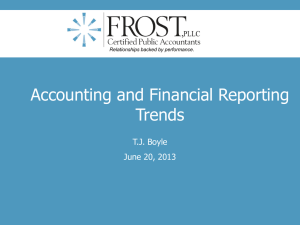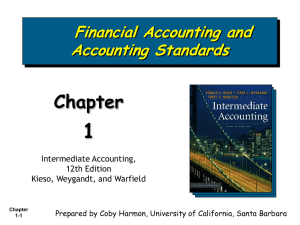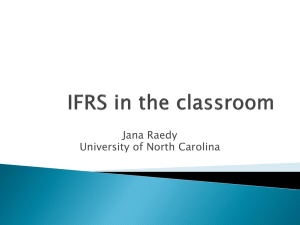KPMG On-Screen Enhanced - Middle Tennessee State University
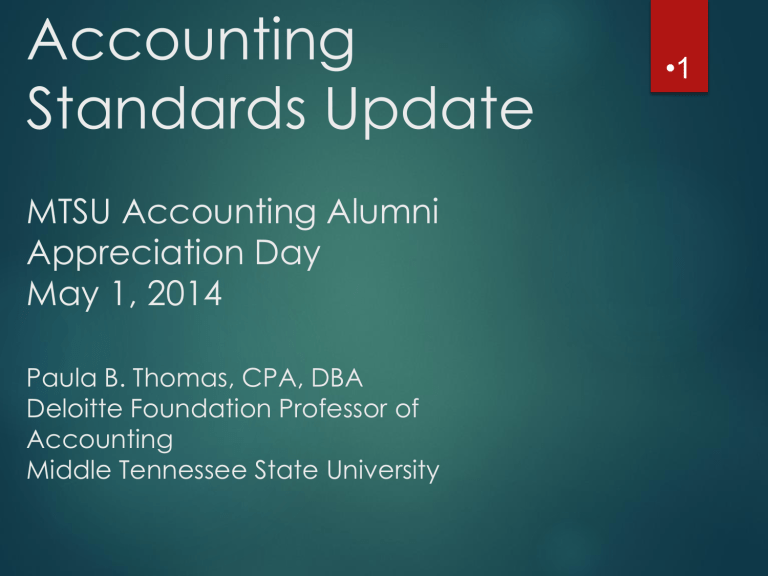
Accounting
Standards Update
MTSU Accounting Alumni
Appreciation Day
May 1, 2014
Paula B. Thomas, CPA, DBA
Deloitte Foundation Professor of
Accounting
Middle Tennessee State University
•1
Topics
Leases
Revenue Recognition
Standard Setting Environment
International Issues
Private company reporting
Other Topics:
Discontinued Operations
Liquidation Basis of Accounting
Fair Value Hierarchy for Nonpublic Entities
•2
Proposed
Changes to
Lease
Accounting
•3
The Big Changes
On March 18 and 19, 2014, the FASB and IASB (the boards) re-deliberated aspects of the joint leasing project including:
the lessee and lessor accounting models
lease term
exemptions and simplifications
The boards voted on a number of items but were unable to reach consensus on certain key issues.
•4
Background
Basic lease accounting model has not changed in more than 30 years
Capital leases (meeting 1 of 4 criteria for lessee)
Operating leases (if none of those criteria are met)
Current lease rules have been criticized for a variety of reasons
Unnecessary complexity
Arbitrary bright line rules
Emphasis of form over substance
One of the biggest “culprits” in off balance sheet financing
•5
Lessee Accounting Model:
Current Status
At least inception:
The boards agree that lessees would need to reflect substantially all leases as a right-of-use asset and a liability,
This includes most leases currently accounted for as operating leases
Subsequent accounting:
Should be based on the nature of the underlying asset
Property (land, building, part of a building, or both) leases (Type B lease) OR
Other than property (Type A lease)
The boards could not come to agreement on the income statement treatment.
•6
Lessee Accounting Model:
Current Status (continued)
Subsequent accounting (continued):
The FASB members support a dual model, but without the bright lines. (Type A leases)
Amortization of the right-of-use asset is recognized separately from interest on the lease liability
Most operating leases under current GAAP would retain a straightline expense recognition pattern (Type B leases)
Expense would be recognized in a single line in the income statement .
•7
The IASB members, on the other hand, support the Type A approach for most leases, resulting in a financial reporting model similar to financing leases today.
They believe this approach has more conceptual merit, and that all leases contain an inherent financing element.
Lessor Accounting Model
IASB supports a model that determines if a lease is effectively a financing/sale (Type A) or not.
A lessor would determine the lease classification by assessing if the lease transfers substantially all of the risks and rewards of ownership
The FASB members support a similar model, except that for Type A leases, they would permit a lessor to recognize a sale at lease commencement only if control of the underlying asset was transferred to the lessee.
•8
Lease Term
The boards agreed that both lessees and lessors would include extension options in the lease term if:
a lessee had a significant economic incentive to exercise such options.
The boards also agreed that a lessee would reassess the lease term only upon the occurrence of triggering events (significant events or changes in circumstances) that were under the lessee’s control. A lessor would not reassess the lease term.
•9
Exemptions and
Simplifications
The boards affirmed short term leases as 12 months or less
Both boards considered adding language that allows lessees to account for similar leases at a portfolio level
Would alleviate some cost and complexity
Differing views on implementation
“Small Ticket” exemption considered, unsure as of now
•1
0
Why is this important?
The proposed lease accounting guidance will affect almost every company and for some, the proposed changes may be significant.
Metrics such as EBITDA and net income will be affected.
These in turn will likely affect loan covenants, credit ratings, and other external measures of financial strength.
Lessees will need to consider business process changes in multiple areas, including finance and accounting, IT, procurement, tax, treasury, legal, operations, corporate real estate and HR.
•11
What’s next?
•12
Deliberations are expected to continue in the coming months.
It is not clear how the boards will resolve their differences or how their current lack of consensus will impact the timing of a final standard.
No expected completion date announced
Revenue Recognition
The new standard: One model, potentially multiple changes for your business
After much deliberation, the FASB and IASB are set to release a final standard, part of the move toward a single set of global accounting standards.
Companies in all industries will use a new five-step model to recognize revenue from customer contracts.
The intent is greater consistency and comparability throughout the global capital markets and across industries.
•13
How the 5 step model works
Step 1: Identify contract(s) with customer
May be written, verbal, or implied by customary business practice.
Contract must have commercial substance
Combine contracts when they are
entered into at or near the same time and are negotiated as a package,
payment of one depends on the other
goods/services promised are a single performance obligation.
•14
How the 5 step model works
Step 2: Identify separate performance obligations in the contract(s)
Performance obligations are promises in a contract to transfer goods or services.
Good or service will represent a separate performance obligation if it is both of the following
Capable of being distinct
Distinct in the context of the contract
Similar to determining stand-alone value under current
US GAAP
•15
How the 5 step model works
Step 3: Determine the transaction price
Entity must determine the amount of consideration to which it expects to be entitled in exchange for the promised goods or services in the contract
Transaction price can be a fixed amount or can vary because of discounts, rebates, performance bonuses/penalties, contingencies, etc.
Contingent consideration is only included in the transaction price when an entity has a “high level of certainty” that the amount of revenue to be recognized would not be subject to future reversals
Additional guidance exists to help make this determination
•16
How the 5 step model works
Step 4: Allocate the transaction price
Price must be allocated to separate performance obligations
This may be the standalone selling price of a good or service when sold separately to a customer in similar circumstances and to similar customers.
If a standalone selling price is not directly observable, estimate it by considering all information that is reasonably available, such as market conditions, specific factors, and class of customers.
•17
How the 5 step model works
Step 5: Recognize revenue when the performance obligation is satisfied
Recognize revenue when the promised goods or services are transferred to the customer.
Performance obligation is deemed satisfied when control of the underlying goods or services is transferred to the customer
More guidance given on making that determination
•18
Where might your company feel impact?
Compensation and bonus plans. Revenue recognition can trigger bonus payments.
Consider how timing changes for revenue recognition affect these and other internal arrangements.
Contracts. Existing terms could take on new meaning under the new standard, so you may need to re-negotiate debt covenants or customer contracts to maintain the original intent.
Technology. You may need to update your current software to capture new information that might not have been necessary before.
•19
Where might your company feel impact?
Tax implications. The timing of cash tax payments could be affected if, for example, you recognize revenue sooner than in the past.
Controls and processes. The standard requires you to make more estimates and disclosures, calling for new controls and processes.
Investor relations. Stakeholders will want to know how your revenue recognition will change and how the new standard affects your company’s financial picture .
•2
0
No more special treatment
“A major milestone in our eleven-year effort to create greater comparability in an area of financial reporting that affects all industries.”—
Russell Golden, FASB chairman, November 6,
2013.
The main objective is to have no industry specific revenue recognition, but that could still change.
•21
Standard Setting
Environment:
International
Issues
•22
Key Questions Regarding
IFRS
Whether to adopt
Despite years of discussion, no final decision
How to adopt
Possible approaches include
full adoption of IFRS without any U.S. endorsement
Little support for this approach
U.S. endorsement of IFRS
option for U.S. issuers to apply IFRS
SEC reports “substantial support” for exploring other methods of incorporating IFRS
•23
How Are IFRS Different than U.S. GAAP?
More “principles-based”
Thus will require more judgment, and perhaps greater diversity in practice
Could pose challenges for auditors
Less extensive
Provides limited industry-specific guidance
Provides less detailed application guidance
Greater use of fair value
•24
Current Status
In July, 2012, SEC issued final staff report related to 2010 work plan.
Report emphasizes that SEC has not made any policy decision regarding
Whether or not IFRS should be incorporated for U.S. issuers
How any such incorporation, if it occurred, should be implemented
SEC says that before making a decision, it must further analyze “the fundamental question of whether transitioning to IFRS is in the best interests of U.S. securities markets generally and U.S. investors specifically”
•25
Current Status, continued
•26
The SEC staff report on the Work Plan (July 2012) did not provide details as to next steps
Discussions in the U.S. have recently focused on incorporating IFRS through FASB endorsing new and existing international accounting standards.
This approach would merge IFRS into U.S. GAAP over a period of years, gradually making the two sets of standards more similar, if not substantially the same.
FASB and IASB are continuing work toward finalizing standards on revenue, leasing, and financial instruments.
These standards will impact virtually all companies, whether they report under U.S. GAAP or IFRS.
Standard Setting
Environment:
Private Company
Financial Reporting
•27
Concerns with GAAP
•28
FASB’s increased use of fair value and perceived focus on public companies
Financial statements may lack relevance to private company users
Increased complexity of FASB standards
Costs of GAAP compliance may exceed benefits
Increase in qualified opinions and use of OCBOA
Problematic standards
income taxes/uncertain tax positions variable-interest entities
Background
Decades old debate about “Big GAAP/Little
GAAP”
More current terminology is “differential standards” or “private company standards”
Playing field changed with differential auditing standards resulting from SOX
More recent efforts to explore private company standards:
Private Company Financial Reporting Committee formed by AICPA and FASB in 2007
Blue Ribbon Panel formed jointly by AICPA, FAF, and
NASBA in late 2009
•29
Process
Blue Ribbon Panel issued its recommendations to
FAF in January, 2011. Recommendations included:
Creation of a new private-company standards board that would focus on making exceptions and modifications to U.S. GAAP for private companies
Would report to FAF, similar to FASB and GASB
Creation of a new differential accounting framework that would allow the FASB to make appropriate and justifiable exceptions and modifications
Did not recommend developing separate set of private company GAAP from scratch
•30
FAF Response
On October 4, 2011, FAF issued a proposal to create the Private Company Standards
Improvement Council (PCSIC) that would work toward improving the accounting standardsetting process for private companies
Council would establish criteria for determining whether exceptions or modifications to standards are needed for private companies
Based on those criteria, Council would propose and vote on specific exceptions or modifications to
GAAP
All proposed changes would be subject to FASB ratification
•31
FAF Response, continued
•32
On May 23, 2012, FAF approved formation of the
Private Company Council (PCC)
Primary PCC responsibilities
To determine whether exceptions or modifications to existing non-govermental U.S. GAAP would benefit private company financial statement users
To advise FASB re consideration of private company issues on FASB technical agenda
Any GAAP modifications/exceptions developed by PCC (with 2/3 majority vote) will become final if endorsed by FASB
NASBA has discouraged the use of private company standards
Private Company
Framework
On April 15, 2013, FASB and Private Company
Council jointly issued an invitation to comment on a proposed private company decision-making framework
The Framework provides guidance for the Board and Council to determine whether and in what circumstances to modify US GAAP for private companies.
•33
Private Company
Framework, continued
The framework identifies six differentiating factors between public and private companies:
Types and number of financial statement users
Access to management
Investment strategies
Ownership and capital structures
Accounting resources
Learning about new financial reporting guidance
•34
Private Company
Framework, continued
The framework also identifies five areas where financial accounting and reporting guidance might differ between public and private companies:
Recognition and measurement
Disclosures
Display (presentation)
Effective date
Transition method
•35
Private companies mull adoption of accounting alternatives
•36
To date, PCC has granted three exceptions
Some private companies—both family-owned and private-equity owned—are showing significant interest in early adopting one or all of the new alternatives.
The basics of the accounting alternatives
The first alternative simplifies accounting for goodwill.
It allows a private company to amortize goodwill on a straight-line basis over a period of up to ten years
Also apply a trigger-based, single-step impairment test at either the entity level or the reporting unit level
The second alternative allows private companies (but not financial institutions) to apply simplified hedge accounting to their receive-variable, pay-fixed interest rate swaps, as long as the swaps meet certain criteria.
The third alternative exempts private companies from consolidating VIEs under common-control leasing arrangements
•37
Benefits of Alternatives?
Private companies can elect to apply one or both of the alternatives in their 2013 financial statements
•38
Issues with choosing alternatives
Private companies considering one or more alternatives cite two primary motivations:
Simplifications will save time and expense, and
Existing accounting guidance provides little perceived benefit to users of their financial statements.
Companies that adopt any of these alternatives would need to "unwind" them if they become an
SEC-registered company, or are otherwise required to have their financial statements included in an SEC filing.
•39
Proposed AICPA SME
Framework
On November 1, 2012, the AICPA issued an exposure draft on its proposed special-purpose financial reporting framework for small and medium-sized entities (FRF for SMEs)
Intended for use by SMEs not required to prepare financial statements in accordance with GAAP
Comment period has ended, and AICPA anticipates releasing its final framework late this spring
Framework was published in late 2013 and chaired by David Morgan of LBMC
The framework is downloadable at no charge on the AICPA website.
•40
Proposed AICPA SME
Framework, continued
The AICPA notes that the FRF for SMEs draws on a blend of traditional methods of accounting with some income tax methods
Excerpt from AICPA website
“The FRF for SMEs™ accounting framework is designed for America's small business community. It delivers financial statements that provide useful, relevant information in a simplified, consistent, costeffective way. The FRF for SMEs™ framework may be used when GAAP financial statements are not required.
Applicable across a wide variety of industries
Note: This is a non-GAAP approach
•41
Examples under Proposed
AICPA Framework
No separate reporting for OCI or extraordinary items
Push-down accounting permitted under specified circumstances
Goodwill and other intangibles would be amortized
•42
Other Topics
•43
Discontinued
Operations
•44
Background for Changes
•45
Major point of the newly issued ASU is to substantially converge the definition of a discontinued operation under US GAAP and
IFRS
Goal is to report as discontinued operations only disposals that represent significant strategic shifts
FASB concern with current GAAP
Allows too many disposals of assets to qualify for discontinued operations presentation, resulting in financial statements that are not decision useful
Inconsistency with current practice
Key Aspects
•46
Expands the disclosure requirements for disposals
Discontinued operation defined as either of the following
A component of an entity that meets all of the following criteria:
It meets either of the following conditions:
It has been disposed of
It meets all of the criteria in ASC 360-10-45-9 to be classified as held for sale
It is part of a single coordinated plan to dispose of any of the following:
A separate major line of business
A separate major geographical area of operations
A business that, on acquisition, meets all of the criteria in ASC
360-10-45-9 to be classified as held for sale
Key Aspects, continued
•47
Guidance does not change requirements for presentation of discontinued operations in the financial statements
Guidance requires additional disclosures
Effective dates:
For public entities and some not-for-profits: for annual periods beginning on or after December 15, 2014 and interim periods within that year
For other entities: annual periods beginning on or after December
15, 2014 and interim periods within annual periods beginning on or after December 15, 2015
Liquidation
Basis of
Accounting
ASU 2013-07
•48
Overview
•49
ASU issued in late 2013
Provides guidance on when and how to apply the liquidation basis of accounting
Provides disclosure guidance
Entities generally will be required to prepare financial statements on the liquidation basis of accounting is liquidation is “imminent”
Liquidation will be considered “imminent” when
A liquidation plan has been approved by those with the authority to do so and the likelihood that either of the following will occur is remote:
Execution of the plan will be blocked by other parties (e.g., shareholders)
The entity will return from liquidation
A liquidation plan is imposed by other forces (e.g., involuntary bankruptcy)
Recognition and Measurement
•50
Entities using liquidation basis of accounting will measure assets at the amount they expect to collect upon sale
This includes assets previously unrecognized under U.S. GAAP, but the company expects to either sell in liquidation or use in settling liabilities
Example - trademarks
Liabilities continue to be recognized at amounts required by
GAAP, and are not re-measured
Companies should not anticipate being legally released as the primary obligor
Entities must accrue
Costs to sell
Income anticipated during liquidation, if there is a reasonable basis for estimation
Costs that will be incurred through the end of liquidation (e.g., payroll, legal fees), if there is a reasonable basis for estimation
Fair Value
Hierarchy
Disclosure for Nonpublic
Entities
•51
Overview
•52
ASU issued in mid 2013
Objective is to clarify applicability of fair value disclosure requirements for nonpublic entities
All nonpublic entities are exempt from having to disclose the fair value hierarchy level (1, 2, or 3) for fair value measurements of financial assets and financial liabilities that are disclosed in the footnotes but not reported at fair value in the balance sheet
Example: Entity’s own debt measured at amortized cost in the balance sheet with fair value disclosed in the footnotes
Questions and
Discussion
•53

